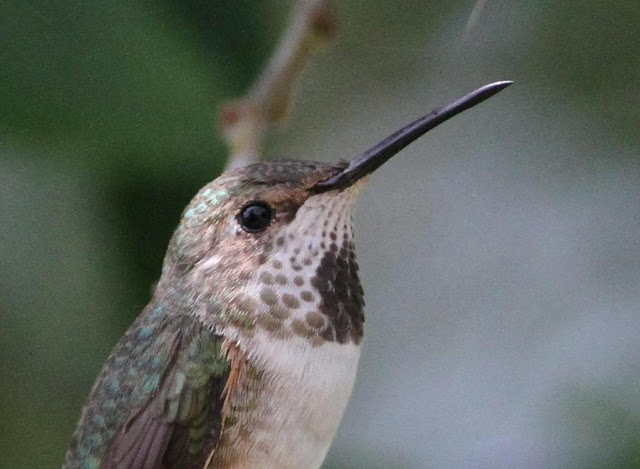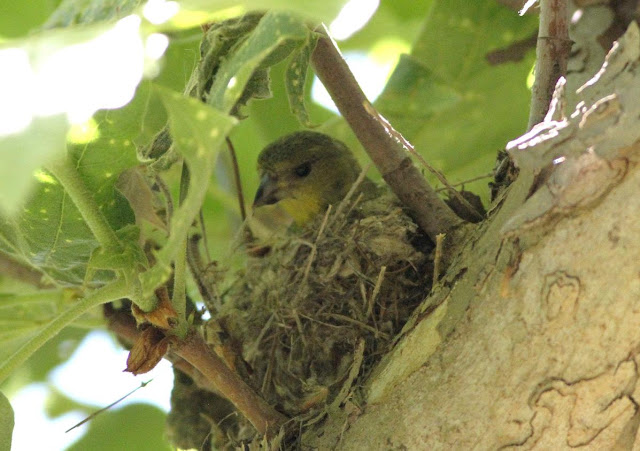This week has been quite windy and with heavy winds coming
from the northwest, I found a place to bird that is somewhat protected from the
wind but also has a reputation for being one of the hot spots for spotting the
new arrivals. Hoping to find some unusual bird subjects, it's time to go to San
Andres Trail at the San Dieguito Lagoon.
When looking for birds in the Arroyo willows that have
leafed out, it can be quite a challenge. I feel much frustration trying to spot bird movement as the wind is gusting through the newly sprouted green
leaves and a lot of patience and luck is required to stay and wait for your bird
subjects. A female Allen's Hummingbird watches my every move.
The area I am searching is only about 150 feet from the
trail entrance. There is a bridge that crosses a little creek and on the south
side of the trail, the land slopes down towards the San Dieguito River bed and
forms a natural wind barrier that also feels a few degrees warmer. The ground is
covered with evening primrose and some are starting to bloom. This is a
really pretty and unique area that seems to attract a lot of visiting
birds. Here is a close-up of this beautiful Allen's Hummingbird.
The little hummer in flight.
One last shot of this curious hummer.
I spot an unusual bird that I haven't seen before. It appears
to be a Vireo of some kind. Perhaps a Warbling Vireo... a life bird for me! He
had no wingbars and a dark-colored back with light undersides.
Warbling Vireo, Vireo gilvus
measures 5.5 inches long with a wingspan of 8.5 inches.
Back view.
3/4 view.
Side view.
A nice pose.
Front view.
Another visitor is spotted in the same area. A
Yellow-breasted Chat shows off his beautiful yellow breast.
Yellow-breasted Chat , Icteria
virens measures 7.5 inches with a wingspan of 9.75
inches.
A look at his black lores and bill.
A topside view and he disappears into the thick willows.
Disappointed that the Chat didn't stick around for closer
shots, I hear a familiar call and find this bird subject in a nearby branch. He
is singing his heart out. It's the male Common Yellowthroat.
He grabs a quick snack between songs.
Back to singing.
He is one beautiful bird.
Common Yellowthroat, Geothlypis trichas measures 5
inches long with a wingspan of 6.75 inches.
More singing.
Only the males have the black mask on the face.
One last shot of the Common Yellowthroat. As I walk towards the bridge spotting two
new visitors that just flew in.
One appears to be a male Brown-headed Cowbird.
The other dark bird displays his wing and tail feathers. He repeats this
display several times and then both birds flies off.
Thinking that it's a good time to start for home, I spot something yellow in the
willows again. Hoping it was the Yellow Warbler that I have been hearing for the
last hour, I focused the camera lens on the quick-moving bird. It turned out to
be a Wilson's Warbler.
Front view.
Peaking through the willows.
Posing for the camera.
Wilson's Warbler, Cardellina pusilla measures 4.75
inches long with a wingspan of 7 inches.
A cutie!
Side View.
A look at his under-wings as he take off to another tree.
As I am ready to head home an Anna's Hummingbird makes an
appearance in front of where I searching for that Yellow
Warbler.
My goodness, she is flying into her little hidden nest.
She pauses in front of her nest but it's too late, I've already spotted her little
treasure.
She settles in to brood.
What a wonderful find. The nest is only about 3 feet off the ground but well hidden. I hope to see the nestlings soon.
As I walk towards the parking area, I hear that familiar
call again that tells me there is a Yellow Warbler near. I search and search and
sure enough, there he is! But this is the only shot I get as he makes a quick
exit out of the area. Well I will just have to see if I can get some shots on my
next visit to this wonderful little birding spot.












































































